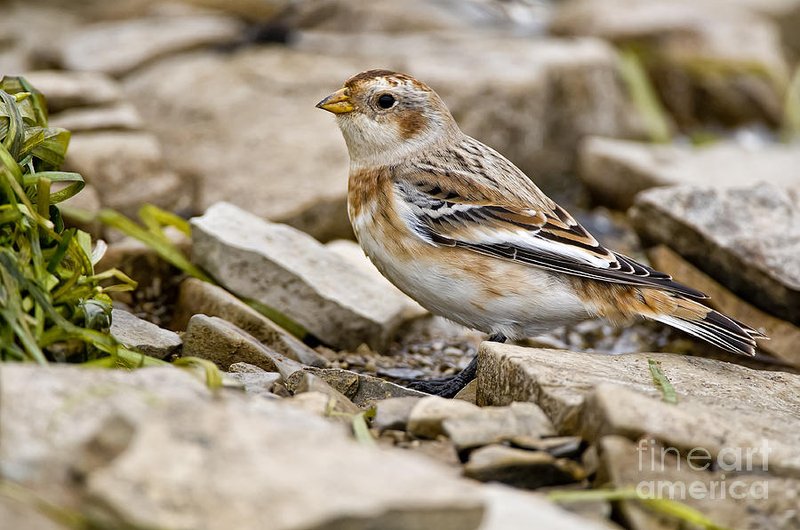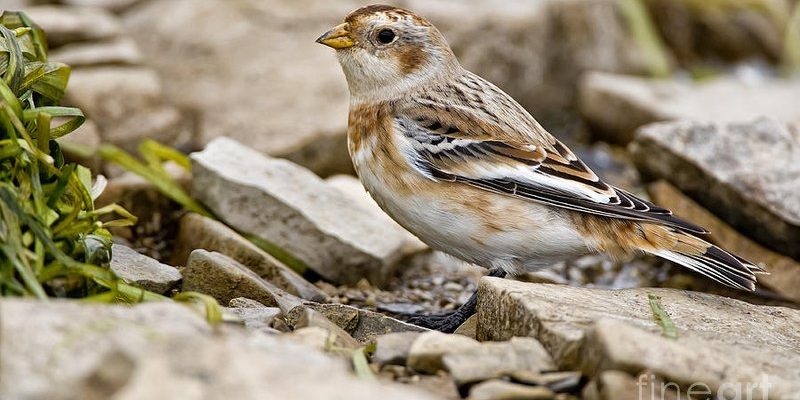
The snow bunting is a small bird that captivates birdwatchers and nature enthusiasts alike with its striking appearance and remarkable adaptations. Imagine a winter landscape blanketed in snow, and amidst this serene white canvas, you spot a bird with a mix of black and white feathers fluttering by. These birds are not only beautiful but also hardy, thriving in some of the coldest areas of the world. They are like little bundles of joy that seem to cheer up the bleakest of winter days.
Snow buntings are fascinating for their migratory behavior as well. They travel from breeding grounds in the Arctic to milder areas during the colder months, showcasing a remarkable journey that many birds undertake. This migration is not just a seasonal event; it’s a crucial survival tactic that allows them to find food and suitable habitats. If you’ve ever felt the urge to escape to a warmer place during winter, you can relate to the snow bunting’s instinct to migrate!
Physical Characteristics
Snow buntings are compact, with a body length ranging from about 14 to 16 inches. Their wings are pointed, helping them navigate through strong winds and harsh conditions. During the mating season, the males flaunt their stunning plumage, which is primarily white with contrasting black wings and a hint of brown. This coloration is not just pretty; it serves as camouflage in snowy environments, helping them avoid predators.
As winter approaches, the snow bunting’s plumage changes slightly, becoming a bit duller to blend in better with the landscape. Females, while less colorful than males, possess a charm of their own with their soft brownish hues that also provide effective camouflage. Their beaks are robust, perfect for cracking open seeds, which form a significant part of their diet.
Habitat and Range
The snow bunting is a true adventurer. Its breeding grounds stretch across the Arctic tundra, where they nest in rocky crevices and cliffs. These remote areas provide protection from predators and harsh weather. During the breeding season, which takes place from late May to early July, snow buntings make nests lined with grasses, feathers, and even their own down feathers, creating a cozy haven for their young.
As the seasons change and temperatures drop, they migrate southward, often found in open fields, coastal areas, and even rural settings across Canada and the northern United States. It’s during this time that you’re likely to spot them foraging for seeds on the ground or fluttering around in small, energetic flocks. Their adaptability to different habitats makes them quite a resilient species.
Diet and Feeding Habits
Snow buntings are primarily granivores, meaning they have a diet rich in seeds. They love to munch on seeds from grasses, weeds, and even agricultural crops. During the winter months, finding food can be challenging, but these little birds have honed their skills. They often forage on the ground in areas where snow has melted or where they can find exposed seeds.
Besides seeds, in the breeding season, they occasionally supplement their diet with insects, which provide essential protein for their growing chicks. Observing their feeding behavior can be quite enjoyable. They often hop around, using their strong beaks to dig through snow or debris in search of food. This adaptability in diet is vital for their survival across various environments.
Breeding and Nesting
The breeding behavior of snow buntings is a fascinating aspect of their life cycle. Males arrive at the breeding grounds first, singing to attract females and establish their territory. Once paired, the male and female work together to build a nest, usually located on the ground or in rocky crevices that provide protection. The female lays around 3 to 6 eggs, which she incubates for about two weeks.
After the chicks hatch, both parents take an active role in feeding them. The parents search for seeds and insects, bringing food back to the nest to ensure their little ones grow strong. It’s incredible how these tiny birds manage to raise their young in such harsh environments, driven by instinct and nurturing behavior. The young birds fledge about two weeks after hatching, ready to start their own adventures.
Migration Patterns
One of the most intriguing aspects of the snow bunting’s life is its migration patterns. Every fall, they embark on an epic journey from their Arctic breeding grounds to the southern regions of Canada and the northern United States. This migration can span thousands of miles, showcasing an innate navigation ability that scientists are still studying today.
Migration isn’t just about getting to a warmer place; it’s a matter of survival. As temperatures drop and snow covers their food sources, these birds instinctively know it’s time to move. They often travel in flocks, providing safety in numbers as they navigate the myriad dangers of migration, such as predators and inclement weather.
Conservation Status
Currently, the conservation status of the snow bunting is considered to be stable, but there are some concerns about their populations. Changes in climate and habitat loss due to agricultural expansion can impact their breeding grounds and food availability. It’s a delicate balance, and as a species that depends on specific habitats, they may face challenges as their environments change.
Birdwatchers and environmentalists are keeping a close eye on snow bunting populations. Supporting conservation efforts and protecting their habitats can play a significant role in ensuring these charming birds continue to thrive. If you ever have the chance to see them in the wild, remember that your experience contributes to a greater understanding of the importance of protecting wildlife.
Interesting Facts About Snow Buntings
| Fact | Details |
|---|---|
| Size: | 14 to 16 inches in length |
| Habitat: | Breeds in Arctic tundra, migrates to open fields and coastal areas |
| Diet: | Primarily seeds; occasionally insects during breeding season |
| Migration: | Travels thousands of miles from the Arctic to southern Canada and northern U.S. |
| Life Span: | Around 3 to 5 years in the wild |
| Nesting: | Nests typically on the ground or in rocky crevices |
| Flocking Behavior: | Forms flocks during migration and non-breeding season |
Snow buntings may be small, but they pack a big punch in terms of beauty and resilience. Their ability to thrive in some of the harshest conditions on Earth makes them a true testament to the wonders of nature. Whether you catch a glimpse of them fluttering through the snow or hear them chirping in the fields, these birds are a reminder of the delicate balance of our ecosystems. Protecting their habitats and understanding their behaviors not only enriches our lives but ensures that future generations can enjoy the sight and sounds of snow buntings.
FAQ
What is the snow bunting’s range during migration?
The snow bunting migrates primarily from the Arctic regions to southern Canada and the northern United States during the winter months. Their migratory journey can cover thousands of miles, and they often stop in open fields and rural areas where food is more accessible.
How can you identify a snow bunting?
Snow buntings are identifiable by their distinct black and white plumage, especially during the breeding season when males showcase their vibrant colors. Both genders have small, rounded bodies and are about the size of a sparrow. Look for their unique wing patterns and cheerful chirping sounds when spotting them in the wild.
What do snow buntings eat in winter?
During winter, snow buntings primarily eat seeds from grasses and weeds, scavenging for food on the ground in areas where snow has melted. They adapt to their environment, feeding on whatever is available, including agricultural crops when necessary.
Are snow buntings social birds?
Yes, snow buntings are quite social, often seen in flocks, especially during migration. This flocking behavior provides safety in numbers, allowing them to forage and travel together. You might see them hopping around in groups, chirping to each other as they search for food.
How long does it take snow bunting chicks to fledge?
After hatching, snow bunting chicks typically fledge around two weeks old. During this time, both parents are actively involved in feeding them and keeping them safe until they are ready to leave the nest and start their own journeys.
Do snow buntings migrate alone or in flocks?
Snow buntings generally migrate in flocks rather than alone. This collective movement not only helps them navigate more effectively but also provides safety from predators. Traveling together can make the long journey feel less daunting for these small birds.
What threats do snow buntings face?
Snow buntings face several threats, including habitat loss due to agricultural expansion and climate change, which may alter their breeding grounds. These factors can impact their food availability and nesting success, making conservation efforts crucial for their survival.
Can snow buntings be found outside of North America?
While snow buntings are primarily found in North America during the winter months, they also breed in parts of Europe and Asia. Their range can extend to various northern regions, adapting to different habitats as they migrate.
What is the lifespan of a snow bunting?
In the wild, snow buntings typically have a lifespan of around 3 to 5 years. However, some individuals may live longer, depending on environmental conditions and threats they face. Their resilient nature helps them survive in challenging habitats.
How do snow buntings adapt to harsh winter conditions?
Snow buntings are well-adapted to survive harsh winter conditions through their migratory behavior and physical adaptations. Their plumage provides effective camouflage against the snow, while their robust beaks allow them to forage for seeds even when food is scarce. These adaptations are critical for their survival in extreme environments.
Are snow buntings considered endangered?
Currently, the snow bunting is not classified as endangered, but their populations are monitored due to concerns about habitat loss and climate change. Conservation efforts are important to ensure that they continue to thrive in their natural habitats.

